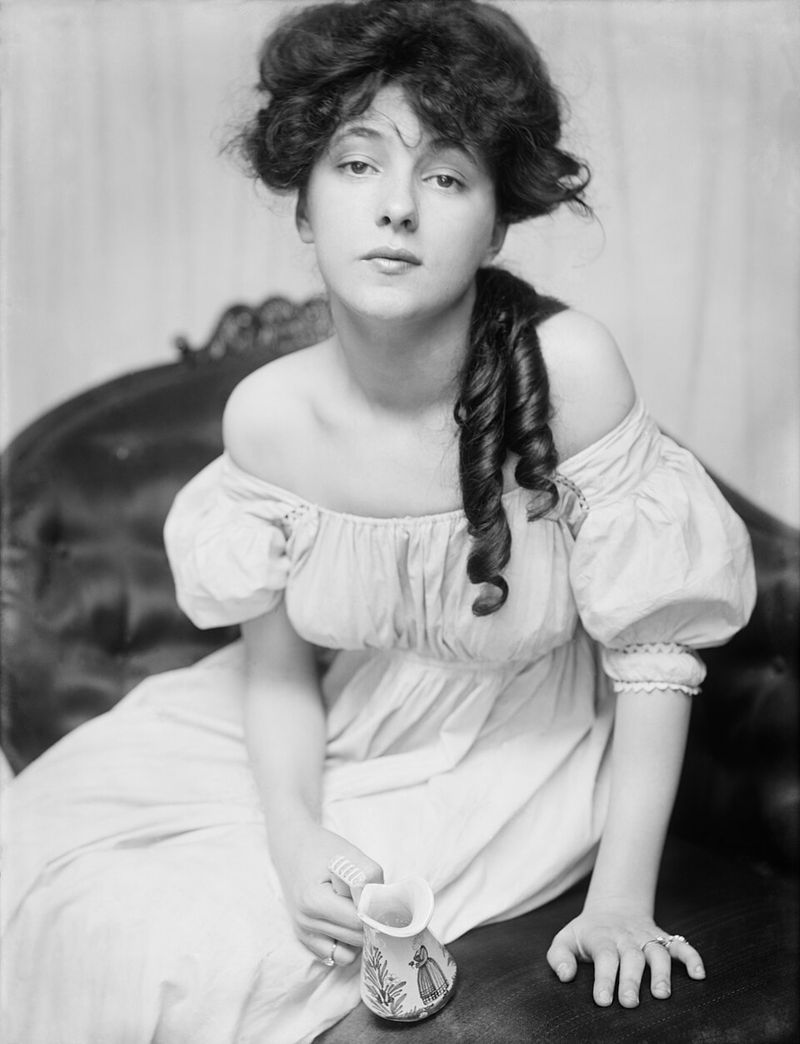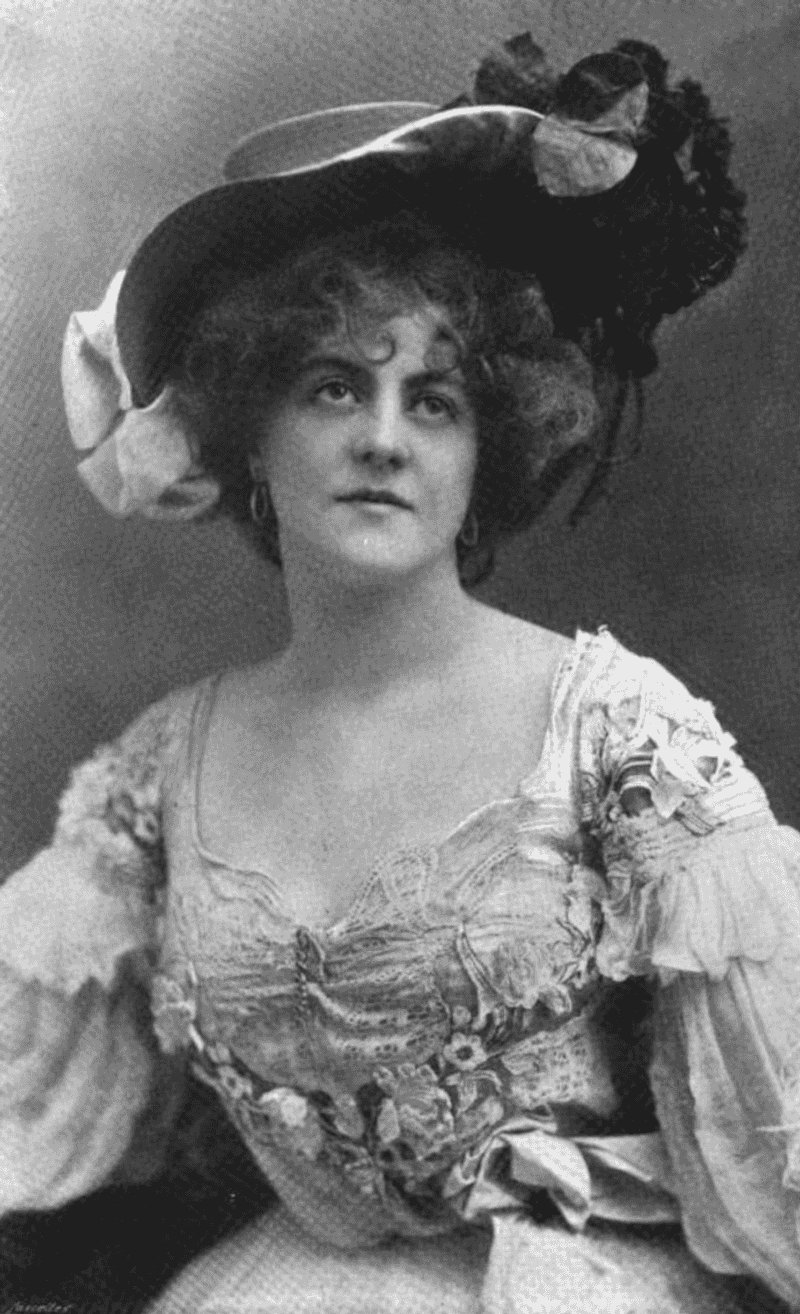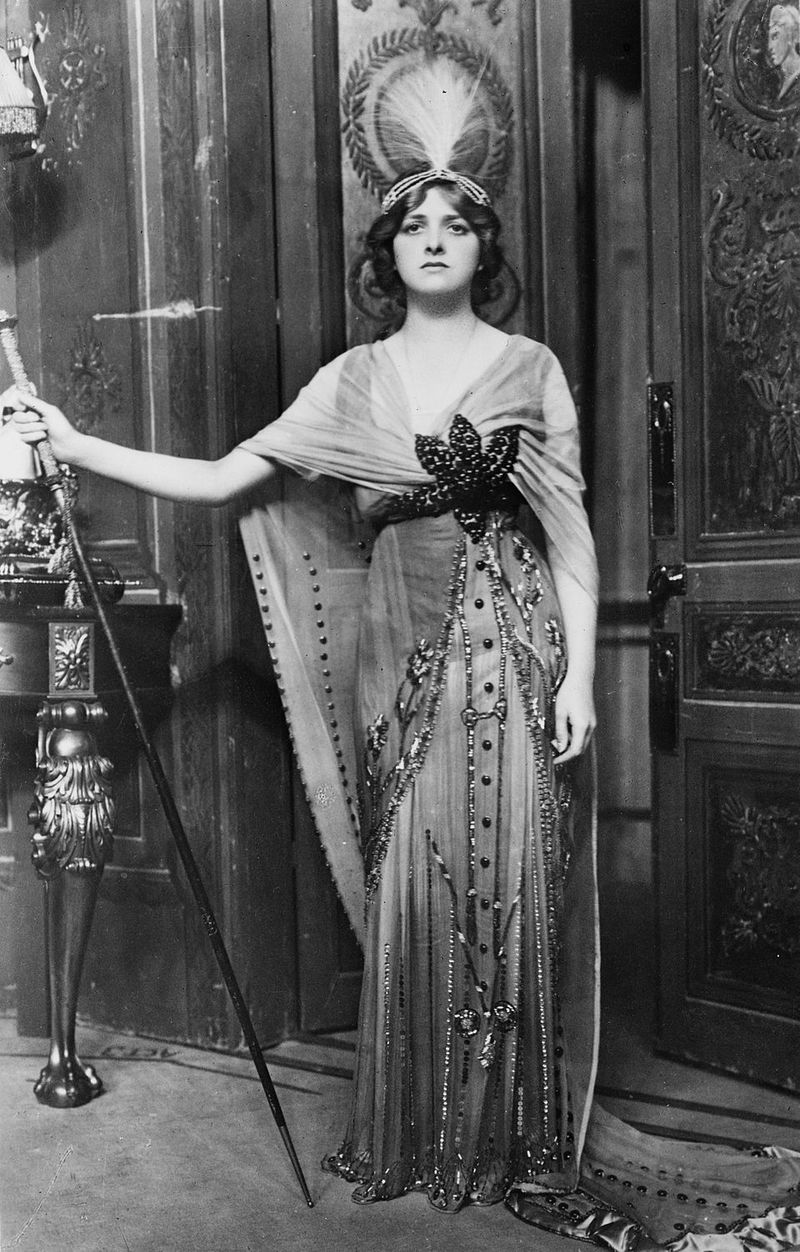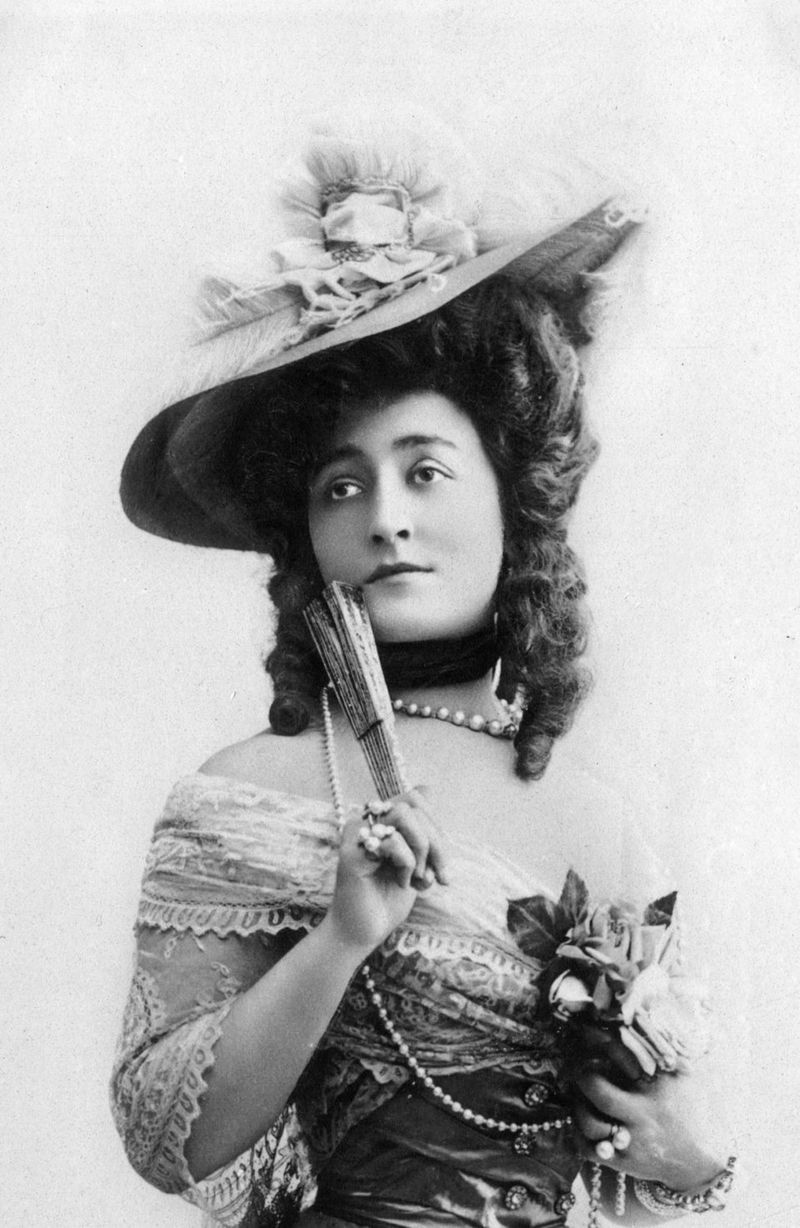Step into an era when postcards, stage lights, and salon portraits shaped the world’s idea of beauty. These 15 legendary women didn’t just grace theater posters—they influenced fashion, photography, and the very language of allure in the early 1900s. From chorus girls turned icons to modern-dance revolutionaries and haute-couture visionaries, their images traveled across continents and decades. Discover how their faces—and stories—defined perfection for a new century.
Evelyn Nesbit (1884–1967)
Evelyn Nesbit embodied the dawn of modern celebrity, a chorus girl whose face launched a thousand postcards and countless painterly studies. As an artist’s model and muse, she crystallized the romantic, softly lit glamour favored by turn‑of‑the‑century photographers. Her notoriety deepened after the sensational 1906 “trial of the century,” when personal tragedy intersected with America’s appetite for scandal. Yet her influence transcended headlines, shaping style sheets and beauty advertisements that codified early 20th‑century ideals. The tilt of her hat, the sweep of her hair, and the serene oval of her face became style shorthand from parlor to department store. Nesbit’s image fused innocence with knowing poise, prefiguring a media age that prized both mystery and memorability. She remains a defining silhouette of Edwardian allure.
Camille Clifford (1885–1971)
Camille Clifford became the living embodiment of the Gibson Girl—an hourglass ideal stylized by illustrator Charles Dana Gibson and imitated worldwide. With her impossibly narrow waist, statuesque carriage, and lofted pompadour, Clifford distilled Edwardian elegance into a single, memorable silhouette. She performed on stage, but her true theater was the camera: carefully staged portraits that blended sculpture and fashion. The curve of her S‑bend corsetry, the sweep of satin gowns, and the regal turn of her chin forged an icon. Clifford’s fame offered a blueprint for aspirational femininity, influencing dressmakers, hair stylists, and editorial illustrators. Her image wasn’t merely pretty; it taught viewers how to look. Even today, mention the Gibson Girl and the mind conjures Clifford’s poised, luminous profile—perfect form made legendary.
Marie Studholme (1872–1930)
Marie Studholme was a musical-comedy favorite whose cherubic features and beaming stage presence made her one of the Edwardian era’s most photographed stars. Postcard culture adored her: she smiled from mantelpieces and scrapbooks across Britain, turning theatergoers into devoted collectors. Her portraits captured the fashion essentials of the time—puffed sleeves, feathery trims, and jeweled accents—yet it was her open, sincere expression that lingered. Studholme’s image softened the theatrical into the intimate, translating stage charisma into everyday companionship through print. She represented the approachable side of beauty, demure yet confident, alive with musical verve. As new media spread rapidly, she flourished as a friendly, aspirational face, both glamorous and neighborly. In her, the Edwardian public found a star who seemed to smile just for them.
Lily Elsie (1886–1962)
Lily Elsie captivated audiences as the luminous lead of The Merry Widow, transforming theater costume and society fashion in one swoop. Her hats became news items, her gowns the talk of London drawing rooms. Photographers adored her porcelain complexion and serene gaze, which translated into iconic publicity stills that shaped early beauty advertising. Elsie’s allure hinged on restraint: a composed smile, a graceful tilt of the head, and an aura of rarefied calm. She made elegance feel effortless, as if beauty were a quiet, perfectly timed breath. Designers collaborated to refine her image, turning the stage into a runway of whispered trends. In the reflection of her portraits, the Edwardian public learned a new vocabulary: poise, polish, and the glamour of understatement.
Gladys Cooper (1888–1971)
Gladys Cooper’s beauty was crystalline—cool, composed, and exacting—perfect for the precise lenses of Edwardian studios. Beginning as a stage favorite, she moved seamlessly into film, carrying the poise of a society portrait into every medium. Her early photographs emphasize clarity: clean profiles, luminous skin, and sculptural hairstyles that showcased a symmetry critics adored. Cooper’s elegance suggested discipline, as if refinement were a habit rather than a moment. This quality made her a fashion bellwether, a face that elevated millinery and collar lines simply by wearing them. She embodied a cultivated ideal that felt attainable through effort and taste. The image she left behind is not feverish glamor but durable grace—an assurance that beauty can be measured, balanced, and beautifully lit.
Isadora Duncan (1877–1927)
Isadora Duncan revolutionized movement and, in doing so, reimagined beauty. She rejected corsets for flowing tunics, turned away from rigid poses toward natural light and open space. Photographs show her barefoot, draped in Grecian lines, a body speaking a new visual language of freedom and emotional truth. Her features—strong, sculptural, unadorned—glowed with conviction rather than ornament. Duncan’s beauty was kinetic, inseparable from motion and philosophy, and it echoed through fashion, photography, and modern dance. She inspired artists to see the body as architecture and wind, not just surface. In a world of carefully pinned coiffures, she let the hair breathe, the fabric billow, the spirit lead. Her legacy: an aesthetic of authentic movement that still feels daringly contemporary.
Cécile Sorel (1873–1966)
Cécile Sorel reigned over Parisian stages with diamond-bright wit and a wardrobe to match. Her portraits sparkle with couture flourishes—plumes, brocade, and audacious jewels—presented with the self-possession of a grande dame. Sorel’s face, all angles softened by expert lighting, communicated high society as theater and theater as high society. She set fashion currents from her dressing room, proving that performance and style could be the same act. In Belle Époque salons, she was both muse and model—studied, emulated, endlessly discussed. Photographers framed her as a living advertisement for Parisian chic, an embodiment of elegant bravado. The result is an image vocabulary of sparkle and spine: beauty that knows its power, and wields it with a playful, sovereign smile.
Ethel Clayton (1890–1966)
Ethel Clayton bridged stage and silent film with a luminous presence that cameras eagerly magnified. Her portraits favor clarity and warmth: expressive eyes, graceful jawline, and a soft cascade of hair setting off a confident smile. In publicity stills, she mastered that early cinematic gaze—open, direct, and subtly dramatic. Clayton’s look captured the transition from Victorian reserve to modern self-possession, making her a staple in beauty roundups of the era. She modeled fashionable blouses and hats as naturally as she carried a scene. The effect is distinctly American: friendly elegance with a hint of forward momentum. She helped audiences trust the camera’s intimacy, proving that beauty could be both approachable and star-bright on the silver screen.
Aida Overton Walker (1880–1914)
Aida Overton Walker electrified vaudeville with artistry and poise, redefining beauty on her own terms. As a dancer, singer, and choreographer, she fused sophistication with showmanship, elevating Black performance styles for mainstream audiences while honoring their origins. Her portraits radiate control—sleek costumes, steady gaze, and precision in every line. Walker advocated for dignity onstage and off, mentoring younger artists and crafting narratives that celebrated glamour without caricature. Beauty, for her, was agency: choosing how to be seen, shaping taste through excellence. The ornamentation in her costumes—beads, feathers, shimmering trims—served the movement rather than eclipsed it. She remains a standard-bearer of elegance and innovation, a star whose radiance helped expand the very definition of stage beauty.
Jeanne Margaine‑Lacroix (1868–1930)
Jeanne Margaine‑Lacroix was a couturière whose radical gowns reshaped silhouettes, making fashion’s beauty inseparable from design. Her “robe mince” streamlined the figure, anticipating modern lines and shocking onlookers accustomed to heavy corsetry. Portraits of her models—and occasionally of the designer herself—convey slick fabrics, vertical emphasis, and a confident stride. Beauty here is engineered: seams as architecture, drape as persuasion. Margaine‑Lacroix demonstrated that the atelier could be a stage, with fittings as choreography. She taught the public to see elegance in motion, not just in portraits. By refining the body’s outline, she reframed the face, too—lifting posture, lengthening necks, and changing how light caressed the wearer. Her legacy is a blueprint for sleek, fearless modernity.
Marie Doro (1882–1956)
Marie Doro’s beauty was ethereal, almost weightless—fine features, translucent skin tones, and an introspective gaze that drew cameras close. On stage and in silent film, she evoked a delicate poetry, the kind that thrives in stillness. Photographers emphasized her eyes and the diaphanous textures around them: veils, lace, or gossamer trims that seemed to float. Doro’s image defined a gentler romanticism, counterbalancing bolder Edwardian theatrics. She embodied the hush between notes, making subtlety feel luxurious. As a publicity subject, she invited intimacy rather than spectacle, a whisper instead of a shout. The result is a portfolio of portraits with the quiet power of a sonnet—light, shadow, and a face that remembers before it speaks.
Ethel Warwick (1882–?)
Ethel Warwick balanced modeling and stage work, bringing a sculptural clarity to her photographs that artists prized. Her poses highlight line and proportion—exquisite shoulders, a thoughtful profile, and garments chosen to sketch the figure in light. Warwick’s images thrive on simplicity: a plain backdrop, a luminous blouse, and a gaze that suggests self-editing elegance. She understood how to collaborate with the camera, offering a modern frankness amid Edwardian ornament. This equilibrium made her a favorite in beauty compilations, where restraint reads as refinement. As an early model-muse, she bridged theater posters and art studios, proving that performance and portraiture share a grammar. Her legacy is a study in how minimalism, properly lit, becomes magnificence.
















